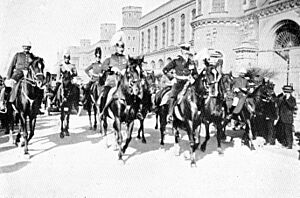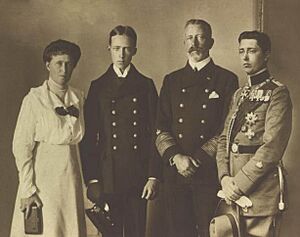Prince Henry of Prussia (1862–1929) facts for kids
Quick facts for kids Prince Henry of Prussia |
|||||
|---|---|---|---|---|---|
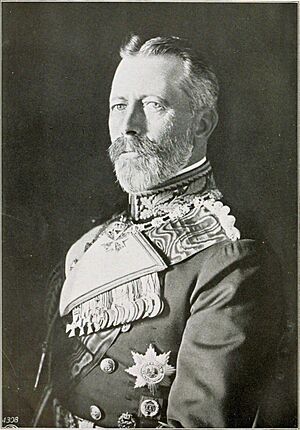
Photograph by Ernest Flagg, 1914
|
|||||
| Born | August 14, 1862 Berlin, Kingdom of Prussia, German Confederation |
||||
| Died | April 20, 1929 (aged 66) Schloss Hemmelmark, Barkelsby, Schleswig-Holstein, Weimar Republic |
||||
| Burial | 24 April 1929 Schloss Hemmelmark, Barkelsby, Schleswig-Holstein, Germany |
||||
| Spouse | |||||
| Issue |
Prince Waldemar
|
||||
|
|||||
| House | Hohenzollern | ||||
| Father | Frederick III, German Emperor | ||||
| Mother | Victoria, Princess Royal | ||||
| Signature | |||||
| Military career | |||||
| Allegiance | |||||
| Service/ |
|||||
| Years of service | 1872–1919 | ||||
| Rank | Großadmiral (grand admiral) | ||||
| Commands held |
|
||||
| Awards |
|
||||
Prince Henry of Prussia (born August 14, 1862 – died April 20, 1929) was a German prince and a skilled naval officer. He was the younger brother of Emperor Wilhelm II of Germany. His mother was Victoria, Princess Royal, which made him a grandson of Queen Victoria of the United Kingdom. Prince Henry spent his career in the Imperial German Navy, rising to the very high rank of Grand Admiral.
Contents
Biography
Prince Henry was born in Berlin on August 14, 1862. He was the third child and second son of eight children. His parents were Crown Prince Frederick William (who later became Emperor Frederick III) and Victoria, Princess Royal. His mother was the eldest daughter of the British Queen Victoria. Henry was three years younger than his brother, the future Emperor William II.
When he was 15, Henry left school and joined the Imperial Navy cadet program in 1877. As part of his training, he went on a two-year trip around the world from 1878 to 1880. He passed his naval officer exam in October 1880 and continued his studies at the German naval academy until 1886.
Because he was a prince, Henry quickly moved up in the navy. In 1887, he commanded a torpedo boat. The next year, he was in charge of the Imperial yacht SMY Hohenzollern. From 1889 to 1890, he commanded several other ships, including the SMS Irene, the Beowulf, the Sachsen, and the Wörth.
Starting in 1897, Prince Henry led several important naval groups. One of these was a special squadron that helped Germany secure its control over the Kiaochow region and the port of Tsingtao in China in 1898.
Prince Henry was very good at diplomacy. He became the first European royal to be welcomed at the Chinese imperial court. In 1899, he officially became the commander of the East Asia Squadron. Later, he commanded a large fleet of battleships. In 1903, he became the commander of the Baltic Sea naval station. From 1906 to 1909, Henry was the commander of the High Seas Fleet, which was the main battle fleet of the German Navy. In 1909, he was promoted to the highest rank: Grand Admiral.
Prince Henry in World War I
When World War I began in 1914, Prince Henry was put in charge of the Baltic Fleet. Even though his fleet was much smaller than Russia's Baltic Fleet, he managed to keep the Russian forces on the defensive. He stopped them from attacking the German coast until the Russian Revolution in 1917.
After the fighting with Russia ended, Prince Henry's mission was complete. He left active duty in the navy. When the war ended and the monarchy in Germany was dissolved, Prince Henry officially retired from the navy.
Family Life
On May 24, 1888, Prince Henry married Princess Irene of Hesse and by Rhine. She was his first cousin. His parents, Emperor Frederick III and Empress Victoria, were there for the wedding. Henry and Irene had three sons:
| Name | Picture | Birth | Death | Notes |
|---|---|---|---|---|
| Waldemar William Louis Frederick Victor Henry | 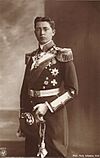 |
March 20, 1889 | May 2, 1945 | Married Princess Calixta of Lippe-Biesterfeld. They did not have any children. |
| William Victor Charles Augustus Henry Sigismund | 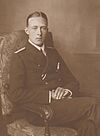 |
November 27, 1896 | November 14, 1978 | Married Princess Charlotte of Saxe-Altenburg. They had children. |
| Henry Victor Louis Frederick | 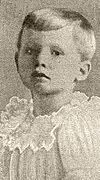 |
January 9, 1900 | February 26, 1904 | He had haemophilia and died at age four after bumping his head. |
Two of their sons, Waldemar and Henry, had haemophilia. This is a rare inherited blood condition where blood does not clot properly. They inherited this condition through their mother, Irene, from their great-grandmother, Queen Victoria, who was a carrier of the gene.
Personality and Interests
Prince Henry was known for being very interested in new technology. He was one of the first people in Germany to get a pilot's license. He was also a very skilled sailor. He quickly understood how useful new inventions could be.
He loved yachting and was one of the first members of the Yacht Club of Kiel, which was started by naval officers in 1887. He quickly became the club's main supporter.
Henry was also very interested in cars. Some people say he invented the windshield wiper, and others say he invented the car horn! In his honor, a famous car race called the Prinz-Heinrich-Fahrt (Prince Heinrich Tour) was created in 1908. This race was an early version of what would become the German Grand Prix.
After the German Revolution, Prince Henry lived with his family in Hemmelmark, a place near Eckernförde in Schleswig-Holstein. He continued to enjoy motor sports and sailing. Even when he was older, he was very successful in sailing races. He also helped make the Prince Henry cap popular, which is still worn by sailors today.
In 1902, during a visit to the United States, he received an honorary degree (a special award for learning) from Harvard University.
Prince Henry died on April 20, 1929, in Hemmelmark, from throat cancer.
Images for kids



